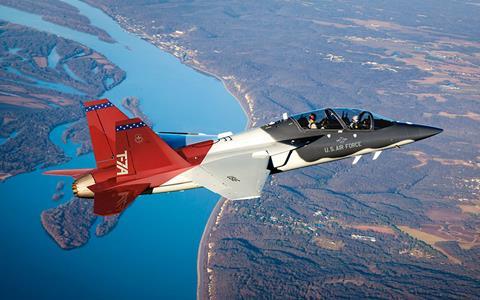The US Air Force (USAF) is studying a future fighter fleet that might include new Lockheed Martin F-16 fighters or possibly a clean-sheet 4.5th-generation fighter.
The service has for years advocated for recapitalising its fleet with stealth aircraft, in particular the Lockheed F-35. However, in 2020 it deviated from that stealth aircraft buying plan and began purchasing the Boeing F-15EX to replace ageing F-15Cs.

The F-15EX is an updated variant of the Cold War-era McDonnell Douglas F-15. The USAF says its lower operating costs as well as similar MRO and training requirements to the F-15C were why the fourth-generation fighter was chosen. It also has a larger weapons payload, which might allow the fighter to carry long-range hypersonic missiles. In contrast, the F-35 has been dogged by high operating costs and maintenance troubles.
Now, it seems the USAF is expanding its interest in fourth-generation fighters. It is considering buying a new-build variant of the F-16 or even a clean-sheet design aircraft, says General Charles Brown, chief of staff of the USAF.
“One of the areas we are pushing through is a [tactical air] study for the United States Air Force, to look at what is the right force mix,” he says. “There is a high-end fight. There’s also a mixture for low-end fight.”
Despite acknowledging interest in the F-16, Brown says he has not ruled out starting from scratch.
“I want to be able to build something new and different, that’s not the F-16,” he says. “I want to entertain a clean-sheet design of something that’s not necessarily fourth-gen, but may not be completely fifth-gen either. There’s some other low-end type things in our high-end fight. We need to have the right force [mix].”
Brown says there are some capabilities that the USAF might not be able to get out of the 1970s-era F-16.
“Operational flight profile, we have to wait for those and it’s every couple [of] years,” he says, describing combat aircraft software upgrades. “I was just at Kessel Run (a USAF software development laboratory) yesterday and they said, ‘Instead of waiting a year and a half, you can do this within a matter of minutes by updating the code on an airplane, particularly if you saw a new threat.’ Versus the way we’ve done things in the past, you don’t have that in the F-16 today.”
The idea for a clean-sheet 4.5th-generation aircraft was inspired by the digital engineering work that allowed Boeing to design the T-7A advanced jet trainer in a few years and the work that also allowed the service’s top-secret Next Generation Air Dominance (NGAD) platform to be designed and test flown in a matter of years, says Brown.
“If we’re going to do software defined, and we have the capability to do something even more capable for cheaper and faster, why not?” he says. “That’s what we’ve learned with our e-series approach with the T-7, and, what we learned with the NGAD. So, the question is: What is the son of NGAD?”
Ultimately, the decision on a clean-sheet 4.5th-generation aircraft would come after analysis and consultation with the Office of the Secretary of Defense and US Congress, Brown says.
“Tac Air has to do some analysis to show what is the right mix, not only capability, but also in numbers, to ensure we are going to be successful in future conflicts,” he says. “That requires some modelling and simulation, and analysis. That’s what I plan to do here over the upcoming months. As we really get into the budget for FY23, that’s where I see that we’ll really make some key decisions.”



























